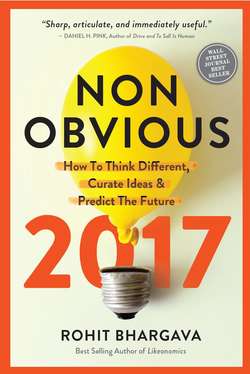Читать книгу Non-Obvious 2017 Edition - Рохит Бхаргава - Страница 50
На сайте Литреса книга снята с продажи.
Step 2—Aggregating
ОглавлениеPhoto: Aggregated stories, sorted into groupings of similar topics or related ideas.
Aggregating involves taking individual ideas and disconnected thoughts and grouping them together based on bigger themes.
Once you have been diligently gathering ideas, the next step is to choose a time to go and combine the early results of your observation and curiosity with thoughtful insights about what it means and how it fits together.
When you move from gathering to aggregating, you are taking the first step toward adding bigger insights to stories and ideas. Using a series of questions can help you do that – and here are some of my favorites.
| AGGREGATING QUESTIONS—How to Group Ideas |
| What broad group or demographic does this story describe?What is the underlying human need or behavior that this idea is an example of?What makes this story interesting as an example?How is this same phenomenon affecting multiple unrelated industries?What qualities or elements make me interested in this story? |
At this stage it is important to remember that industries or categories don’t matter for grouping. When sorting, don’t fall into the “obvious” trap of putting all the financial services examples together or putting every story related to Facebook together.
Aggregating involves sorting ideas based on insights and human motivations, not industries or demographics.
For example, when I was preparing my 2012 Non-Obvious Trend Report, I collected marketing stories of new campaign strategies from three different companies, Domino’s Pizza, Ally Bank (an online consumer bank) and Aviva (world’s sixth largest insurance provider). The industries across these examples ranged from banking to food services to insurance.
The shared lesson behind each of their efforts though was how companies were finding new ways to avoid being faceless and find their humanity, so I aggregated them together in a group and wrote on an index card “companies being more human.”
In this second step, it is not important to come up with a fancy name or even to do extensive research around any stories. Instead, you want to start building small clusters of ideas which bring together disconnected concepts into broader groups to be analyzed later.
